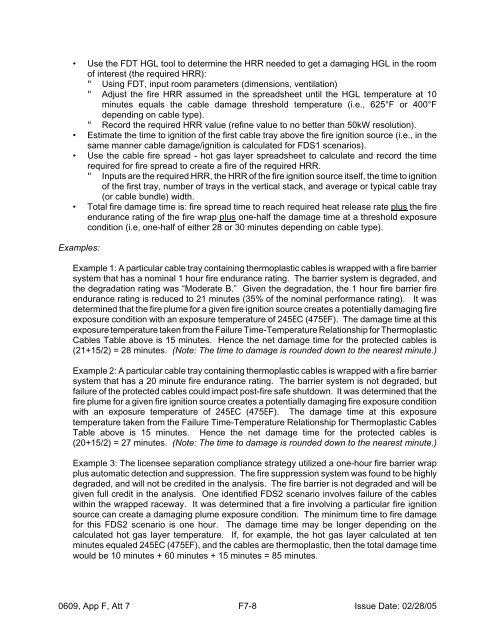IMC 0609, App F, Att 7 - NRC
IMC 0609, App F, Att 7 - NRC
IMC 0609, App F, Att 7 - NRC
You also want an ePaper? Increase the reach of your titles
YUMPU automatically turns print PDFs into web optimized ePapers that Google loves.
• Use the FDT HGL tool to determine the HRR needed to get a damaging HGL in the room<br />
of interest (the required HRR):<br />
" Using FDT, input room parameters (dimensions, ventilation)<br />
" Adjust the fire HRR assumed in the spreadsheet until the HGL temperature at 10<br />
minutes equals the cable damage threshold temperature (i.e., 625°F or 400°F<br />
depending on cable type).<br />
" Record the required HRR value (refine value to no better than 50kW resolution).<br />
• Estimate the time to ignition of the first cable tray above the fire ignition source (i.e., in the<br />
same manner cable damage/ignition is calculated for FDS1 scenarios).<br />
• Use the cable fire spread - hot gas layer spreadsheet to calculate and record the time<br />
required for fire spread to create a fire of the required HRR.<br />
" Inputs are the required HRR, the HRR of the fire ignition source itself, the time to ignition<br />
of the first tray, number of trays in the vertical stack, and average or typical cable tray<br />
(or cable bundle) width.<br />
• Total fire damage time is: fire spread time to reach required heat release rate plus the fire<br />
endurance rating of the fire wrap plus one-half the damage time at a threshold exposure<br />
condition (i.e, one-half of either 28 or 30 minutes depending on cable type).<br />
Examples:<br />
Example 1: A particular cable tray containing thermoplastic cables is wrapped with a fire barrier<br />
system that has a nominal 1 hour fire endurance rating. The barrier system is degraded, and<br />
the degradation rating was “Moderate B.” Given the degradation, the 1 hour fire barrier fire<br />
endurance rating is reduced to 21 minutes (35% of the nominal performance rating). It was<br />
determined that the fire plume for a given fire ignition source creates a potentially damaging fire<br />
exposure condition with an exposure temperature of 245EC (475EF). The damage time at this<br />
exposure temperature taken from the Failure Time-Temperature Relationship for Thermoplastic<br />
Cables Table above is 15 minutes. Hence the net damage time for the protected cables is<br />
(21+15/2) = 28 minutes. (Note: The time to damage is rounded down to the nearest minute.)<br />
Example 2: A particular cable tray containing thermoplastic cables is wrapped with a fire barrier<br />
system that has a 20 minute fire endurance rating. The barrier system is not degraded, but<br />
failure of the protected cables could impact post-fire safe shutdown. It was determined that the<br />
fire plume for a given fire ignition source creates a potentially damaging fire exposure condition<br />
with an exposure temperature of 245EC (475EF). The damage time at this exposure<br />
temperature taken from the Failure Time-Temperature Relationship for Thermoplastic Cables<br />
Table above is 15 minutes. Hence the net damage time for the protected cables is<br />
(20+15/2) = 27 minutes. (Note: The time to damage is rounded down to the nearest minute.)<br />
Example 3: The licensee separation compliance strategy utilized a one-hour fire barrier wrap<br />
plus automatic detection and suppression. The fire suppression system was found to be highly<br />
degraded, and will not be credited in the analysis. The fire barrier is not degraded and will be<br />
given full credit in the analysis. One identified FDS2 scenario involves failure of the cables<br />
within the wrapped raceway. It was determined that a fire involving a particular fire ignition<br />
source can create a damaging plume exposure condition. The minimum time to fire damage<br />
for this FDS2 scenario is one hour. The damage time may be longer depending on the<br />
calculated hot gas layer temperature. If, for example, the hot gas layer calculated at ten<br />
minutes equaled 245EC (475EF), and the cables are thermoplastic, then the total damage time<br />
would be 10 minutes + 60 minutes + 15 minutes = 85 minutes.<br />
<strong>0609</strong>, <strong>App</strong> F, <strong>Att</strong> 7 F7-8<br />
Issue Date: 02/28/05
















